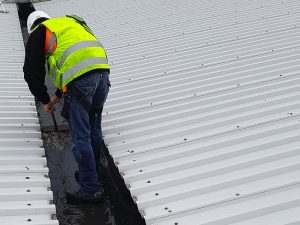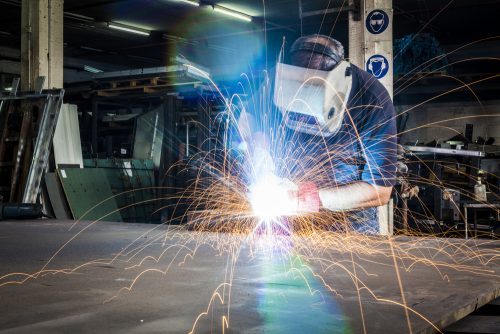The roof of your building is the protective layer that keeps your building and business warm and dry. Its job is to keep the rain, snow and wind out and the heat in. We can’t control the weather, but we can control how well we look after the roof that protects our buildings.
A well-maintained roof is likely to have a long life expectancy and will be able to withstand even the most severe weather conditions like strong blustery winds, heavy rain and thick snow. Looking after your roof during the winter months is particularly important in certain areas of the UK where brutal weather conditions are becoming more and more common.
However, at some point, you will have to consider roof repair or replacement to ensure that your business premises are safe and secure for everyone who works in it. This blog post provides advice about how to spot weaknesses in your roof so that you can keep on top of maintenance, when repairing it is appropriate and when it needs to be replaced.

How To Identify When Your Commercial Roof Needs Repairing
Keeping your existing roof well-maintained is vital if you want it to last. Leaving minor roof repairs until they become major, increases roof repair costs and ultimately may result in it needing to be replaced.
Get to know your commercial roof and how it works. If you’ve had it replaced, talk to the roofing contractors about the best way to maintain it and prepare a schedule of work that keeps you on top of roof repairs. If the existing roof was fitted by the previous owners of the building, see if you can find out who fitted it and ask for their advice about effective maintenance.
Some of the things you need to keep an eye out for include:
- Wind drafts
- Leaks
- Interior water stains
- Mould and strong odours
- Damaged guttering system
- Flashing damage
Wind Drafts
If you can feel a draft coming from your roof, it needs to be investigated. It doesn’t matter whether you have a flat roof or a pitched roof, it shouldn’t be letting in a draft. If your roof is letting in the cold, it will also be letting out up to 25% of heat which will have an impact on its energy efficiency rating and your fuel bills.
Wind drafts are a common issue and the problem may be that the fixings have failed and laps have become susceptible to wind uplift. If that’s the case, tackling the problem quickly and addressing the issue will help to keep your roof repair costs to a minimum.
Leaks
Another red flag that alerts you to the fact that your roof isn’t working as well as it should is water ingress. Whether you’ve got a couple of drops during heavy rain, or a constant stream, a leaking roof needs to be addressed quickly to find out where the roof has failed. Water will often find the lowest point to drip which may be quite a way from the cause of the leak. Causes of water ingress could be due to one of many factors including, but not limited to, the following: cut edge corrosion, failed fixings, rooflight damage, cracked/punctured membrane.
Regular maintenance checks by a professional roofer will help you identify the issue quickly and get the damaged roof repaired or replaced so that it doesn’t cause any further damage.
Interior Water Stains
Water will find its way through your roof if there are even the smallest of openings. These types of leaks may not be apparent until you see water stains appearing on the ceiling. Tackling the cause of the stain quickly will minimise the amount of internal damage and reduce the roof repair cost.
Mould / Strong Odours
If you spot mould on the walls or ceiling, or a strong odour, the chances are the problem may be coming from your roof. A small leak that goes unnoticed for a long period of time creates dampness in the ceiling materials which is the perfect place for mould to grow.
Damaged membrane or damaged sheets may be the cause, so getting your roof checked over if mould appears on your ceiling is a good place to start when you are trying to identify the source of the dampness.
Damaged Gutter System
The purpose of guttering is to protect your home from water damage caused by rain and snow. Without an adequate guttering system, rainwater collects on your roof and will ultimately cause damage such as rotting wood and mould which in turn can damage other areas of your roof. As we experience more common and substantial downpours, it is becoming more and more evident that many guttering systems on roofs are not designed to cope with the volume of rain.
Blocked or damaged guttering can lead to a build-up of rain or snow that will eventually find its way into the building causing damage. This occurs in a flat or pitched roof, regardless of the type of roofing material used. If gutters are blocked this can cause a backfilling effect, directing water back into the building.
When To Consider Roof Replacement
However well your maintenance programme is, there will come a point when you have to consider if it’s worth continuing to carry out roof repairs or if it’s going to be more cost-effective in the long run to replace all, or part of your existing roof.
If there is a recurring problem with your roof, or a strong storm causes unavoidable damage, roof replacement may be the best option. Once you’ve reached that point, it’s best to get the work done as soon as possible. Leaving it for a period of time is likely to increase roof replacement costs as further damage could be caused the longer it is left untreated.
Unless you are a roofer, this is something that you won’t be able to carry out yourself. There are many benefits to hiring professional roofers, not least because it’s the safest way to replace your roof. A roofing contractor will also be able to advise you about adding different elements to your roof such as rooflights and other features, that will not only provide you with a first-class new roof, but will add value to your property and save you money in energy costs.
| Advantages | Disadvantages |
| A new roof will increase the value of your business premises particularly if your existing one is badly fitted or in a bad state of repair. | A large outlay in terms of cost. |
| A roof replacement will reduce the need for internal repairs caused by a leaking or damaged roof. | Depending on the size of your premises, replacing the roof can take several weeks. |
| A sound roof protects your workers from some of the issues associated with damage such as leaks, cold and draughts, and problems caused by mould. | A full roof replacement is likely to cause some disruption to the running of your business. |
When To Consider Roof Repair
If you have an effective maintenance programme, your roof will be able to withstand severe weather conditions and last for many years. Regularly removing rubbish and debris from the guttering, inspecting water outlets, replacing leaf guards and damaged flashings and carrying out repairs as soon as they are needed will help to increase the life of your roof.
Seek advice from a professional roofer who will advise you about roof repair costs and whether they are a cost-effective way of dealing with issues.
| Advantages | Disadvantages |
| Regularly carrying out roof repairs is cheaper than a full replacement. | Repairs may be less cost-effective if they do not solve a recurring problem. |
| Roof repairs can increase the lifespan of your roof. | They may not address other issues such as dampness and mould caused by recurring leaks. |
| Repairs can rectify faulty work or replace incorrect materials without the need for a full roof replacement. | May not solve the issue properly. |
How Much Does It Cost To Repair A Roof?
Roof repair costs will vary depending on the size of the area that needs to be worked on, the type of materials used and the extent of the damage, as well as the health and safety precautions that are required to carry out the works in a safe manner.
Get in touch with roofing contractors such as Roofclad Systems who will be able to give you a free and comprehensive quotation for the cost of the necessary repairs.
How Roofclad Systems Can Help Minimise Commercial Roofing Costs
Here at Roofclad Systems, we focus on delivering the best service for our clients by using quality materials and skilled labour. Our hard work doesn’t stop at the fitting. We offer a range of maintenance checks and refurbishment plans so that you can be sure your roof is being well looked after. Our hard work doesn’t stop at the fitting.
Our Maintenance Checks and Refurbishment Plan includes:
- Quarterly / Bi-Annual / Annual site visits.
- Removal of all rubbish, debris and leaves from roof areas and gutters.
- Inspect all rainwater outlets, and replace leaf guards.
- Keep water free flowing. In light of climate change, it is more important than ever to ensure all gutters and rainwater pipes are free-flowing, especially on older buildings where they were designed for rainfall rates which are significantly less than current standards.
Our aftercare services are available to help you look after your roof, extending its life so that you don’t need a full replacement.
Get In Touch Today
Roofclad has a range of services that will help you look after your roof and provide you with expert advice about your options if the time comes for it to be replaced.
Get in touch with our team today to find out about all of our services and how we can help you get the most from your commercial roof. If you’ve found this blog post useful, check out our knowledge hub that’s packed full of tips and advice that answers all of your roofing questions.

 9 Minutes Read
9 Minutes Read  31/01/2024
31/01/2024 



